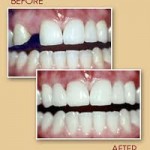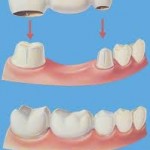What is a dental bridge? 
A dental bridge is also known as a fixed partial denture. It is used to replace a single missing    tooth or a short span of missing teeth. It is a permanent prosthesis, which is joined to the tooth    or implant adjacent to the space created by the missing tooth. Before the bridge is fabricated, the   adjacent tooth on both sides of the missing space is prepared (a cantilever bridge requires only   one adjacent tooth to be prepared). The tooth is reduced to the appropriate size, depending on the  material used to fabricate the bridge. The reduced tooth will serve as the anchor unit, holding the  bridge in place. A dental bridge can be fabricated using all metal, all porcelain, porcelain fused to  metal or gold. 
Why do you need to replace a missing tooth?
A missing tooth can pose problems to the existing dentition. Tooth adjacent to the space created by the missing tooth can drift forward. If the missing tooth is not replaced the space will get smaller due to the closing of the space by forward movement of the tooth. Future replacement of the tooth will be difficult as the small space will not permit the placement of a prosthesis of the actual size of the tooth. Movement of tooth can also occur vertically. For example, if a lower tooth is missing the existing upper opposite tooth can erupt downwards as there is no opposing force to maintain the position of the tooth. Movement of tooth in these directions will alter the occlusion and directs abnormal force to the dentition. This will affect the temporomandibular joint, leading to pain, discomfort and clicking.
Options for replacement of a missing tooth
1. No replacement- If a patient has a longstanding edentulous space, and no drifting of the adjacent tooth or elongation of the opposing tooth has taken place, then the decision to replace the missing tooth is left to the patient. If the patient is happy with his current appearance and complains of no problem with the occlusion the missing tooth need not be replaced. The adjacent tooth do not always move. Such cases are rare and need to be recognized.
2. Removable partial denture– Removable partial denture (RPD) is indicated if there are more than two posterior or more than four anterior teeth missing. It is also indicated when there are clusters of edentulous span, though each span is short. Multiple and longer edentulous spans are more difficult to replace due to the technical complexity of the bridge and higher cost.
3. Dental bridge– A dental bridge is usually preferred when a missing tooth is to be replaced. It is indicated for a span of not more than two posterior or four anterior teeth. If the abutment teeth are in good condition, the edentulous span is short and straight, and the prosthesis is well designed, the bridge can serve its function for a long time.
Types of bridges
The fabrication of a dental bridge depends on:
1.The number of units it replaces– eg. a 3 unit conventional bridge means the bridge replaces one single missing tooth and uses both the adjacent teeth to the missing space as anchor units, a 4 unit conventional bridge means the bridge replaces two missing teeth with both the adjacent teeth as the anchor units.
2. The way the adjacent tooth is prepared– Conventional bridge requires the adjacent tooth to be extensively and completely prepared compared to an adhesive bridge which requires only minimal preparation. A conventional bridge has higher longevity compared to an adhesive bridge due to its strength.
3. The number of adjacent tooth prepared-If only one abutment tooth (adjacent tooth) is prepared to anchor the bridge, it is known as a cantilever bridge.
4. The way the bridge bonds to the tooth– There are many types of cements used to bond a bridge to the prepared tooth.
5. The material used to fabricate the bridge– Metal bridge requires less reduction of the abutment tooth (0.8-1mm) whereas a porcelain bridge requires more reduction (1-2mm)
Therefore, there are basically three types of bridges:
1. Conventional bridge– It requires preparation of the whole tooth surface. Both the adjacent tooth or only one of the tooth can be prepared to anchor the bridge.
2. Cantilever bridge– It is a bridge which requires only one adjacent tooth to be prepared
3. Adhesive bridge– Requires both the adjacent tooth to be prepared, but minimally. Only half of the tooth surface is prepared to retain the bridge. It is normally used to replace the front tooth and when the adjacent teeth are in good condition. Â